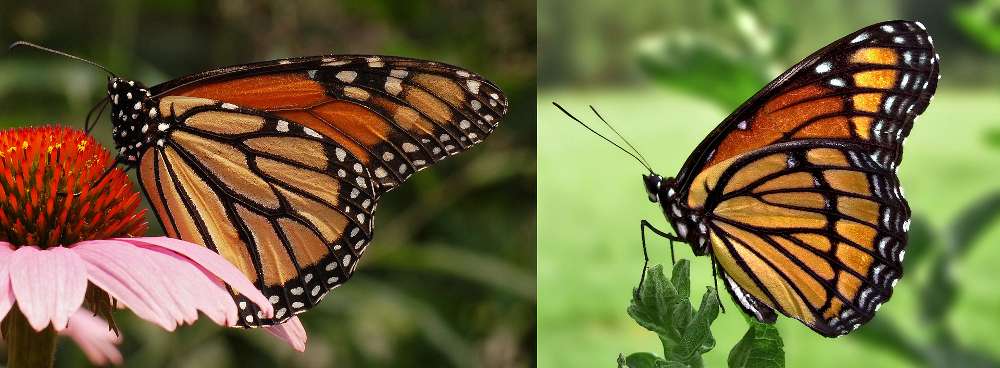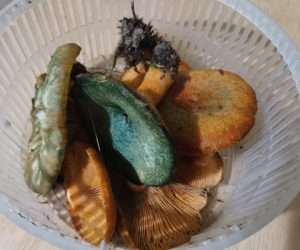 Imagine you are walking through the forest, and you see a bright red mushroom with white spots. You decide to leave it alone because you figure that in nature bright red means something is poisonous or otherwise inedible. Later on, you come across another red mushroom, this one with a more crusty texture. You leave it behind as well. As it turns out, you successfully avoided bringing home fly agaric (Amanita muscaria), but you missed out on the lobster mushroom (Russula or Lactarius spp. infected by Hypomyces lactifluorum), which is a choice edible. So what’s the truth about mushrooms and aposematism?
Imagine you are walking through the forest, and you see a bright red mushroom with white spots. You decide to leave it alone because you figure that in nature bright red means something is poisonous or otherwise inedible. Later on, you come across another red mushroom, this one with a more crusty texture. You leave it behind as well. As it turns out, you successfully avoided bringing home fly agaric (Amanita muscaria), but you missed out on the lobster mushroom (Russula or Lactarius spp. infected by Hypomyces lactifluorum), which is a choice edible. So what’s the truth about mushrooms and aposematism?
What is Aposematism?
First, let’s discuss aposematism itself. This is a phenomenon in nature where an organism’s bright colors signal to a potential predator “I’m dangerous! Don’t eat me!” Often these organisms are poisonous, taste terrible, or are covered in spikes, irritating hairs, and other unpleasant things. There are some species that mimic these legitimately troublesome beings even though they themselves are perfectly edible; the viceroy butterfly (Limenitis archippus) on the right looks very much like the monarch butterfly (Danaus plexippus) on the left, but lacks the toxins that the latter absorbs into its tissues from the plants it eats as a caterpillar.

Aposematism is found in many branches of the animal kingdom, from butterflies, beetles, and other insects, to cuttlefish and octopi, to frogs and snakes and skunks and more. Aposematism in plants is still being researched, though there are some species that may very well be brightly colored for the purpose of deterring predators. And, of course, plants display many other defenses such as thorns and unpleasant tastes. It even may be the case that some plants display seasonal aposematism at times when they are most likely to be eaten by herbivores.
Is There a Link Between Mushrooms and Aposematism?
 So what about all those brightly colored mushrooms out there? We’ve already established that some edible species, like the lobster mushrooms, as well as saffron milkcap (Lactarius deliciosus, pictured to the left), chicken of the woods (Laetiporus spp.), and Caesar’s mushroom (Amanita caesaria), among others, are as colorful as the ripe fruit found at the grocery store. And some of the most deadly mushrooms are deceptively plain. Destroying angels (Amanita virosa, Amanita bisporigera, and Amanita ocreata) are large, plain white mushrooms that look similar to a mature edible matsutake (Tricholoma matsutake), while a poisonous conocybe (Conocybe filaris/Pholiotina rugosa) and younger deadly galerina (Galerina marginata) are among the “LBMs”, or “little brown mushrooms”, so named for being small, plain brown, and nondescript enough to be easily mistaken for each other by the novice mushroom hunter (as well as some more experienced ones!)
So what about all those brightly colored mushrooms out there? We’ve already established that some edible species, like the lobster mushrooms, as well as saffron milkcap (Lactarius deliciosus, pictured to the left), chicken of the woods (Laetiporus spp.), and Caesar’s mushroom (Amanita caesaria), among others, are as colorful as the ripe fruit found at the grocery store. And some of the most deadly mushrooms are deceptively plain. Destroying angels (Amanita virosa, Amanita bisporigera, and Amanita ocreata) are large, plain white mushrooms that look similar to a mature edible matsutake (Tricholoma matsutake), while a poisonous conocybe (Conocybe filaris/Pholiotina rugosa) and younger deadly galerina (Galerina marginata) are among the “LBMs”, or “little brown mushrooms”, so named for being small, plain brown, and nondescript enough to be easily mistaken for each other by the novice mushroom hunter (as well as some more experienced ones!)
This would suggest that bright colors are not a universal sign of poison in mushrooms, at least not where human predation is concerned. Some preliminary research suggests that there may be a link between mushrooms and aposematism in at least a selection of species. For example, ergot (Claviceps purpurea) could be warning away herbivores with its distinct purple coloration as it grows on various grasses. Interestingly enough, another study demonstrates that it may be smells rather than colors that help poisonous mushrooms advertise their threat.
So How Do I Tell Poisonous Mushrooms From Edible Ones?
 Unfortunately, without a clear relationship between mushrooms and aposematism, we don’t really have an easy way to tell the mushrooms that will make us sick from the ones that we can safely eat again and again. This is why identification skills are so incredibly important, and why you need to rely on multiple resources like books, websites, and other foragers. With practice you can build up a mental library of which colorful mushrooms are poisonous, which ones are edible and tasty, and which ones can be eaten but are not especially good (like these purple spindles (Alloclavaria purpurea, left).)
Unfortunately, without a clear relationship between mushrooms and aposematism, we don’t really have an easy way to tell the mushrooms that will make us sick from the ones that we can safely eat again and again. This is why identification skills are so incredibly important, and why you need to rely on multiple resources like books, websites, and other foragers. With practice you can build up a mental library of which colorful mushrooms are poisonous, which ones are edible and tasty, and which ones can be eaten but are not especially good (like these purple spindles (Alloclavaria purpurea, left).)
Did you enjoy this article? Consider taking one of my classes on mushroom identification, foraging, and other natural history topics!
